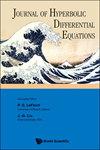具有凸哈密顿量的Hamilton-Jacobi方程的正则性和全局结构
IF 1.1
4区 数学
Q4 MATHEMATICS, APPLIED
引用次数: 0
摘要
我们考虑多维Hamilton-Jacobi (HJ)方程[公式:见文],其中[公式:见文]是一个常数,并且对于有界的[公式:见文]初始数据。当[公式:见原文]时,这是具有一致凸哈密顿量的典型情况。当[公式:见文本],这是几何光学中著名的Eikonal方程,哈密顿量是具有齐次性的Lipschitz连续[公式:见文本]。我们打算填补这两种情况之间的空白。当[公式:见文]时,哈密顿函数[公式:见文]不是均匀凸的,在[公式:见文]的任何邻域中都只有[公式:见文],这就产生了新的困难。特别是,从初始数据的梯度消失的点发出的特征上的点可能是“坏”点,因此奇异集比在这种情况下观察到的更复杂[公式:见文本]。我们从拓扑学的角度建立了奇异集解的正则性和全局结构:解继承了奇异集补中初始数据的正则性,并且奇异集的连通分量与奇异集的路径连通分量之间存在一一对应关系[公式:见文]。本文章由计算机程序翻译,如有差异,请以英文原文为准。
Regularity and global structure for Hamilton–Jacobi equations with convex Hamiltonian
We consider the multidimensional Hamilton–Jacobi (HJ) equation [Formula: see text] with [Formula: see text] being a constant and for bounded [Formula: see text] initial data. When [Formula: see text], this is the typical case of interest with a uniformly convex Hamiltonian. When [Formula: see text], this is the famous Eikonal equation from geometric optics, the Hamiltonian being Lipschitz continuous with homogeneity [Formula: see text]. We intend to fill the gap in between these two cases. When [Formula: see text], the Hamiltonian [Formula: see text] is not uniformly convex and is only [Formula: see text] in any neighborhood of [Formula: see text], which causes new difficulties. In particular, points on characteristics emanating from points with vanishing gradient of the initial data could be “bad” points, so the singular set is more complicated than what is observed in the case [Formula: see text]. We establish here the regularity of solutions and the global structure of the singular set from a topological standpoint: the solution inherits the regularity of the initial data in the complement of the singular set and there is a one-to-one correspondence between the connected components of the singular set and the path-connected components of the set [Formula: see text].
求助全文
通过发布文献求助,成功后即可免费获取论文全文。
去求助
来源期刊

Journal of Hyperbolic Differential Equations
数学-物理:数学物理
CiteScore
1.10
自引率
0.00%
发文量
15
审稿时长
24 months
期刊介绍:
This journal publishes original research papers on nonlinear hyperbolic problems and related topics, of mathematical and/or physical interest. Specifically, it invites papers on the theory and numerical analysis of hyperbolic conservation laws and of hyperbolic partial differential equations arising in mathematical physics. The Journal welcomes contributions in:
Theory of nonlinear hyperbolic systems of conservation laws, addressing the issues of well-posedness and qualitative behavior of solutions, in one or several space dimensions.
Hyperbolic differential equations of mathematical physics, such as the Einstein equations of general relativity, Dirac equations, Maxwell equations, relativistic fluid models, etc.
Lorentzian geometry, particularly global geometric and causal theoretic aspects of spacetimes satisfying the Einstein equations.
Nonlinear hyperbolic systems arising in continuum physics such as: hyperbolic models of fluid dynamics, mixed models of transonic flows, etc.
General problems that are dominated (but not exclusively driven) by finite speed phenomena, such as dissipative and dispersive perturbations of hyperbolic systems, and models from statistical mechanics and other probabilistic models relevant to the derivation of fluid dynamical equations.
Convergence analysis of numerical methods for hyperbolic equations: finite difference schemes, finite volumes schemes, etc.
 求助内容:
求助内容: 应助结果提醒方式:
应助结果提醒方式:


